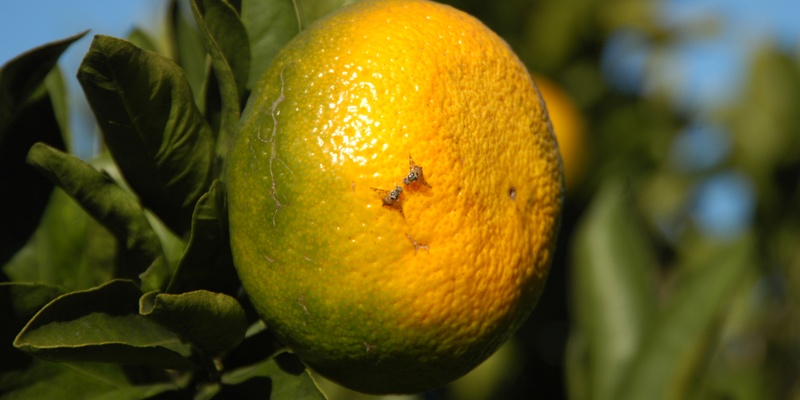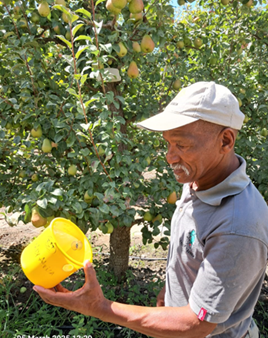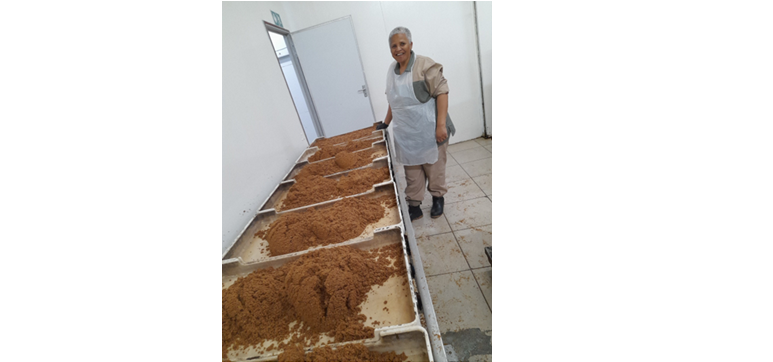SPOTLIGHT: Public-private partnership saves South Africa’s fruit industry from the Mediterranean fruit fly
Posted on Tue, 08 Apr 2025, 11:38

© IAEA/Louise Potterton
For over a decade, South Africa has used a public-private partnership approach to manage the Mediterranean fruit fly (Ceratitis capitata (Wiedemann)), or Medfly, which threatens its fruit industry. Considering this an effective pest management approach, the Strategic Planning Group of the International Plant Protection Convention (IPPC), at its meeting in October 2024, recommended a similar model for managing economically important pests such as Fusarium oxysporum f.sp. cubense Tropical Race 4 (Fusarium TR4).
A high-impact problem
South Africa produces more than 4.7 million tonnes of fruit annually, accounting for over 50 per cent of the country’s agricultural exports and 2.5 per cent of South Africa’s Growth Domestic Product (GDP). South Africa earns about USD 11 million from exporting over 900 000 metric tonnes of deciduous fruit annually, 41 per cent of all locally produced fruit. The rest is processed (39 per cent) or sold locally (19 per cent), providing a valuable source of food and nutrition for the population. South Africa’s fruit industry employs 460 000 people directly on farms and at pack houses.
However, Medfly, one of the world’s most damaging agricultural pests, significantly affects fruits and vegetables, such as citrus, melons, tomatoes, and bell peppers, making them unmarketable or unfit for consumption. Managing Medfly is costly for commercial and small-scale farmers alike therefore requires efficient management.
Tackling Medfly head-on
To secure the South African fruit industry, farmers’ incomes and the economy, in the late 1990s, the Government piloted a Sterile Insect Technology (SIT) programme in the Western Cape. The SIT is among the most cost-effective and environmentally friendly pest control methods through which sterile male fruit flies are mass-produced using irradiation and released systematically into fly-infested areas, where they cannot produce offspring. Applied over large areas, using SIT can effectively and sustainably reduce pest populations. Although underfunded, the programme produced about five million sterile male flies and released about 500 sterile males weekly, per hectare of crop field. The government constructed a larger mass-rearing facility, upgraded the quality control management system and introduced a new genetic sexing strain. Production and quality of sterile flies improved, but more investment was needed for larger production areas. In 2003, the programme was privatized and became the FruitFly Africa (Pty) Limited. Growers had to contribute to Medfly management through a “subsidiary levy”, but many failed, necessitating a new funding model.

Johan Jacobs, FFA monitor, inspecting a fruitfly trap in the Tulbagh deciduous fruit production area. Photo credit: Ghian du Toit
Eureka: A public-private-partnership that works
In 2009, the deciduous fruit and table grape growers and the South African government’s Department of Agriculture Forestry and Fisheries (DAFF) started a private-public partnership, with each side funding 50 percent of the programme. Consequently, the breeding facility was upgraded into a state-of-the-art mass-rearing facility, improving the production and quality of sterile fruit flies.
By 2023, sterile male production had increased to 65 million flies per week, a 1 200 per cent rise since the late 1990s. The recruitment of competent, core staff such as managers and technicians also contributed to this growth. Average wild Medfly populations in the SIT areas decreased by 73 per cent with flies released in a larger area- around 40 000 hectares of commercial deciduous fruit and table grapes per week, between October and May. Some of these areas are currently being managed as areas of low pest prevalence for Medfly, which increases the quantity of (residue-safe) exports.

Sandra Bergstedt, facility worker at FruitFly Africa’s Stellenbosch SIT facility, prepares a batch of larvae diet. ©Courtesy: Ghian du Toit
To ensure that small-holder farmers in the eight targeted fruit production areas benefit, the programme, an Areawide Integrated Pest Management System (AW-IPM), set up Medfly traps and developed a fruit fly bait programme - funded mainly by producers, using a Spinosad-based product instead of commonly used environmentally injurious organophosphate-based products.
“The co-funding approach worked because it was built on a solid cost-benefit analysis and thorough, continuous applied research, to achieve national priorities such as export competitiveness, economic growth and development, job creation, food security, and reduced insecticide use,” says Jan Hendrik Venter, Director, Plant Health Department of Agriculture Land Reform and Rural Development South Africa.
“As a growers’ association, Hortgro is very satisfied with the outcomes of the programme to increase pest surveillance and reduce Medfly in our main production areas. Our farmers are using the most environmentally friendly approach possible to control fruit flies on an integrated area-wide approach. This has reduced import rejections due to pests or chemical residues”, said Anton Rabe, Executive Director Hortgro.
Since the start of this partnership, South Africa’s fruit exports have grown from 558 000 tonnes to 1.02 million tonnes (83 percent growth), ensuring safe trade, livelihoods, economic growth and food security.
The programme also actively engaged stakeholders through clear, timely and comprehensive information. This fostered goodwill and secured long-term commitment, crucial for the success of AW-IPM programmes.
To amplify its success, the SIT programme was integrated into a project funded by the Standards and Trade Development Facility of the World Trade Organization, to identify areas of low pest prevalence and pest-free areas for several fruit fly species in South Africa and Mozambique.

